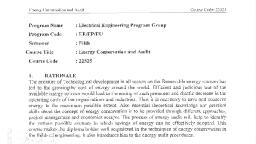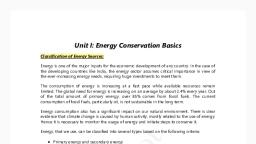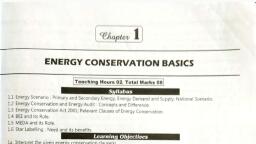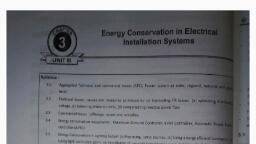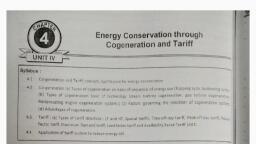Page 1 :
Chapter 1, , , , ENERGY CONSERVATION BASICS, , , , 1.1 ENERGY SCENARIO, , Teaching Hours 02, Total Marks 08), , 11 Energy Scenario : Primary and Secondary Energy, Energy Demand and Supply, National Scenario, 12 Energy Conservation and Energy Audit Concepts and Difference, , 13 Energy Conservation Act 2001; Relevant Clauses of Energy Conservation, , 14 BEE and its Role, , 15 MEDA and its Role., 16 Star Labelling : Need and its benefits., ee MO ca ilncn, la. Interpret the given energy conservation clause(s)., 1b. Explain the specified BEE role(s)., 1c. Explain the specified MEDA role(s), 1d, Interpret the star labelling of the given electrical equipment, , 7. Energy is one of the major inputs for the economic development of any country. In the case of developing, , y, , , , countries, the energy sector assumes a critical importance in view of the ever increasing energy needs requiring, huge investments to meet them. India's per capita energy and electricity consumptions are less than one tenth, of developed countries’ per capita consumption., The disparities in urban versus rural; southern, western and northern region versus eastern and north-eastern, region; and higher income versus lower income households are very high., Unfortunately, the regions where large fossil and renewable energy sources are available have lower per capita, energy consumption. ; F, For sustainable and equitable socio-economic development such a situation needs to change. Given the, country's over dependence on coal, large-scale import of oil and gas, difficulty in meeting the financial burden, of import, environmental consequences of large-scale energy production, transformation, transportation and, use, it is not wise to strive to achieve the developed country level of energy consumption, To improve the quality of life of Indian citizens, there is no doubt that per capita energy consumption has to, increase., Through judicious approach, higher quality of life can be achieved with moderate increase in energy, consumption. The country needs to make timely change of our emphasis on non-renewable energy. Such a, change in strategy calls for a paradigm shift in our development approach, i.e. from a unsustainable growth, oriented economic development to an environmental friendly equitable development., Since three most serious environment related problems (Global warming, acid rain and ozone layer depletion), owe their origin to energy, it is in our national and global interest that we minimise ‘energy want’ without, sacrificing the ‘energy need! for a decent quality of life., , time-bound plan is essential to move to ‘renewable energy dominant decentralised system’ from the existing, ‘non-renewable energy focused, fossil fuel-centric centralised system’. Energy is essential for every activity of life., There is a strong positive correlation between energy use and the quality of life., , Scanned with CamScanner
Page 2 :
Energy Conse,, , Energy Conservation and Audit (Elect, Engg. Gr.) (Sem. V) 1.2 a, , ; ‘ capita ener ., a At global level, Percapita income of a country is directly proportional to the per cap oy CONSUmp¢ a, , Energy can be classified into several t following criteria : y, es based on the fo! ‘, se” Primary and Secondary enerey YP © Commercial and Non-commercial energy, , ¢ Renewable and Non-Renewable energy., Need of Energ Conservation, , , , ° Everyday we flip switches, work in busy factories using energy at a rate which is growing day by day -_, , playing an important role., , It is the central force behind our productivity, our leisure and our environment. oy, , * There is a strong correlation between energy use per capita and standard of living in each economy, «, Per capita energy consumption means a higher Capita Gross National product., , * Low cost energy was available in past. Use of low cost energy for home comfort became very predominan,, , * But in the 1973, oil embargo produced an energy crises, which greatly affected the economy of the \,,.,, resulted into sudden increase in oil prices, increasing the energy cost in every sector., , ¢ The per capita energy consumption in India is very low as compared to that in advanced countries, , * But it is increasing day by day and it is aimed at 1000 kWh per capita per year., , The gap between demand and supply of energy is increasing day by day due to increased usage of elec;, , due to the following reasons., , (a) Increase in population. (b) Increase in standard of living. (c) Increase in Industries. (d) Increase in tran, , The energy reserves of fossile fuels that is coal, oil, and gas are depleting at a fast rate. The increase in dem;, , of energy and depleting energy sources all over the world is resulting in to inflection., , * Increase in cost of energy is affecting individual, social and national life, at the same time economy of th, , « Hence, energy saving is essential in developed as well as developing countries. The energy sav, conservation plan should eliminate wastage of energy without affecting productivity and growth rate, , , , , , , , , , , , 1.1.1 Primary and Secondary Energy|, , , , , , ~# Primary energy sources are those that are either found or stored in nature., .*% Common primary energy sources are coal, oil, natural gas, and biomass (such as wood)., , ¢ Other primary energy sources available include nuclear energy from radioactive substances, thermal en¢’!, stored in earth's interior, and potential energy due to earth's gravity., , Source Extraction Processing Primary energy Secondary energy, , , , , , , a clean, , aiapeme Thermal, , Hydro,, , Nuclear, —, , Natural, gas, 97 ~~ hermal, Pe, Petroleum eral aa Steam, , Diesel / Fuel oils, Scanned with CamScanner
Page 3 :
Energy Conservation and Audit (Elect. Engg. Gr.) (Sem. V) 13 Energy Conservation Basics, , oe The primary energy sources are mostly converted in industrial utilities into secondary energy sources) for, , example, coal, oil or gas converted into steam and electricity, Primary energy can also be used directly, ¢, Some energy sources have non-energy uses, for example, coal or natural gas can be used as a feedstock in, fertilizer plants., , , , , , 1.1.2 Commercial Energy and Non-commercial Energy, , , , (a) Commercial Energy, , e The energy sources that are available in the market for a definite price are known as commercial energy, , By far the most important forms of commercial energy are electricity, coal and refined petroleum products, , e Commercial energy forms the basis of industrial, agricultural, transport and commercial development in the, modern world., , e In industrialized countries, commercialized fuels are predominant source not only for economic production, but, also for many household tasks of general population., , e Examples : Electricity, lignite, coal, oil, natural gas, etc., , (b) Non-commercial Energy, , * The energy sources that are not available in the commercial market for a price are classified as non-commercial, energy., , ¢ Non-commercial energy sources include fuels such as firewood, cattle dung and agricultural wastes, which are, traditionally gathered, and not bought at a price used especially in rural households., , ¢ These are also called traditional fuels. Non-commercial energy is often ignored in energy accounting, , ¢ Example: Firewood, agro waste in rural areas; solar energy for water heating, electricity generation, for drying, grain, fish and fruits; animal power for transport, threshing, lifting water for irrigation, crushing sugarcane; wind, energy for lifting water and electricity generation., , , , , , , , 1.1.3 Energy Demand and Supply, , , , , , y Energy demand is the term used to describe the consumption of energy by human activity, , @ It drives the whole energy system, influencing the total amount of energy used; the location of, and types of fuel, used in, the energy supply system; and the characteristics of the end use technologies that consume energy., , (i) Energy Demand, , » Energy demand is divided into three sectors: (i) electricity, (ji) transportation, and (iii) "heat" which comprises all, stationary uses of energy except for those associated with generating electricity or transportation fuels., , y Energy demand will continue to grow on the back of relatively fast socioeconomic development. It is driven by the, requirement to satisfy mankind's production and living needs. With continued improvements in economic, development and quality of life, demand for energy will continue to soar for a long while, especially in, underdeveloped countries and regions where most of the populations suffering from energy poverty will, gradually live a modern life enriched by the supply of power as a commodity., , * Weare of the view that by the mid-twenty-first century, the gross capacity of the world economy will maintain,, albeit at a slower rate, the rising trend that started at the end of World War Il., , ¢ It is projected that before 2030, the world economy will grow more strongly, but energy-intensive enterprises in, the steel and iron, nonferrous metals, building materials, and chemical engineering industries will experience, slower growth,, , * The production of key products will reach the saturation point in 2030 or thereabouts, with energy demand, maintaining an average growth rate of 1.6%. After 2030, energy-intensive industries will see themselves, degenerating into “sunset industries," with the industrialization and urbanization processes drawing to an end in, most regions, By contrast, the weighting of other industrial, transportation and commercial sectors in the, , economy will rise further, and an overall slowdown in energy demand growth., , (ii) Energy Supply, */ Energy supply is the delivery of fuels or transformed fuels to point of consumption. It potentially encompasses, , the extraction, transmission, generation, distribution and storage of fuels. It is also sometimes called energy flow., , Scanned with CamScanner
Page 4 :
Energy C Energy Conser, ‘gy Conservation and Audit (Elect, Engg. Gr.) (Sem. i) 14 at, , , , , , , -4 National Scenario [India's Global Energy Scenario], , . Our Nation ‘India’ has an bugeameuneae coal reserves upto 60,000/- million tonnes., ° This is sufficie, , t for our Country u 220 years., ; Pto further 200 to y' :, If compared with other countries in the world it is 6 to 7% of the world’s reserve., , if : pe RESEIVES SH E ratio., Ow long this reserve will be available is indicated by the ratio Production ~~ P, * In the world, our count aT anc lanites, vorid, TY stand 4" in the producer of coal and lig, Coal mines are in the different parts of our country ; (1) Bihar, (2) Madhya Pradesh, (3) Maharashtra, Pradesh, (5) Orissa, (6) West Bengal, (7) Jharkhand. : S, (3 ;, The other countries in the world which has largest proved reserves are : (1) China, (2) US, (3) Russia, The RP ratio is 254 years of Europe countries,, As oil is concerned in the current scenario, its consumption is expected to be 2000 MT by the end of 207,, , Total worlds Proved oil reserves are 1500 billion barrels upto 2017. World's proved natural gas rece,, 185 trillion cubic Meters (tcm)., , In rising use of Coal, India's CO; emission is 5.5% of the word's emission., , ENERGY CONSERVATION AND ENERGY AUDIT : CONCEPTS AND DIFFEREN,, , , , , , , , National security, Personal financial security and higher savings., , Energy can be conserved by reducing wastage and losses, improving efficiency through technological upg;, and improved operation and maintenance., , On a global level energy use can also be reduced by the stabilisation of, ¢ In the case of fossil fuels, the conservation also can include findin, that the commonly used oil fields are not drained completely., , Population growth., 9 New ways to tap into the Earth’s Sup, , , , conservation techniques is reduce demand, protect and replenish suppl, sources, and to clean up the damage from the Prior energy Processes,, , 1.2.1.1 Practical Methods of Energy Conservation (Energy Conservation Techniques), , Below are ten energy conservation techniques that can help you to reduce your overall carbon footprint @, save money in the long run., , 1. Install CFL Lights : Try replacing incandescent b, , the more energy it consumes to maintain room temperature. A More smarter and comfortable way of °°, this is to buy a programmable thermostat., , 3. Fix Air Leaks : Proper insulation will fix air leaks that could be costing yo:, be letting out a lot of heat if you do not have a Proper insulation. You «., , pea ete, , lu, During winter months, you **, rife se. 2a, Scanned with CamScanner
Page 5 :
nergy Conservation and Audit (Elect. Engg. Gr.) (Sem. V) 15 Energy Conservation Basics, , 4. Use Maximum Daylight : Turn off lights during day and use daylight as much as possible. This will reduce, , 5s, , the burden on the local power grid and save you good amount of money in the long run., , Get Energy Audit Done : Getting energy audit done by hiring an energy audit expert for your home is an, energy conservation technique that can help you conserve energy and save good amount of money every, month. Home energy audit is nothing but a process that helps you to identify areas in your home where it is, losing energy and what steps you can take to overcome them. Implement the tips and suggestions given by, those energy experts and you might see some drop in your monthly electricity bill., , Use Energy Efficient Appliances : When planning to buy some electrical appliances, prefer to buy one with, Energy Star rating. Energy efficient appliances with Energy Star rating consume less energy and save you, money: They might cost you more in the beginning but it is much more of an investment for you., , Drive Less, Walk More and Carpooling : Yet another energy conservation technique is to drive less and, walk more. This will not only reduce your carbon footprint but will also keep you healthy as walking is a, good exercise. If you go to office by car and many of your colleagues stay nearby, try doing carpooling with, them. This will not only bring down your monthly bill you spend on fuel but will also make you socially more, active., , Switch Off Appliances when Not in Use : Electrical appliances like coffee machine, idle printer, desktop, computer keep on using electricity even when not in use. Just switch them off if you don't need them, immediately., , Plant Shady Landscaping : Shady landscaping outside your home will protect it from intense heat during, hot and sunny days and chilly winds during the winter season. This will keep your home cool during summer, season and will eventually turn to big savings when you calculate the amount of energy saved at the end of, the year., , 10. Install Energy Efficient Windows : Some of the older windows installed at our homes are not energy, , efficient. Double panel windows and other vinyl frames are much better than single pane windows. Choosing, correct blinds can save on your power bills., , .2.1.2 Other Energy Conservation Techniques, , The other few energy conservation techniques may surprise you. While there are practical methods such as, ) insulation, (2) changing light sources, (3) using alternate fuels and (4) carpooling rather than walking —, derstand the 6 core techniques beneath them will show you more about what to do in life., x Core Techniques :, , 1., , Education : Education is probably the most powerful of the energy conservation techniques that can be, , used. Education is about more than teaching people the importance of conservation, it is about showing the, , alternative choices that can be used in construction, manufacturing and other processes., , Zero Energy Balance : Zero Energy Balance is more than techniques of conserving energy in green, , construction. It is a process of re-evaluating and retrofitting manufacturing and commercial operations, , so that they can harvest and store energy, as well as take and replace it onto the grid to relieve brown out, , stresses., , Alternative Power : There are more processes that are starting to use alternative power and fuel sources in, , many different areas of life. The use of alternative power is one of the most key energy conservation, , techniques because almost all of the transition models require that the existing processes be upgraded or, , replaced to more energy efficient models too., , Cap and Trade Agreements : Cap and trade agreements are used as part of the Proce of fegulating and, conserving consumption and pollution for manufacturing industries. The companies are allowed a certain, emission rate which they can bid buy to extend. The extension bid is then used for compensating projects., While this may not seem like it is directly related to energy conservation it is very much at its core., , Reduced Demand : There are numerous initiatives that are working to reduce the overall demand on the, energy resources of the world. This can range everywhere from education programs to changing the type of, , watinn in naw canstruction., , , , Scanned with CamScanner

